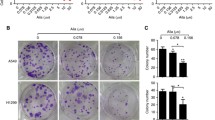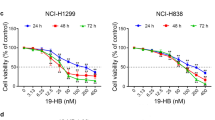Abstract
Bufalin, a naturally occurring small-molecule compound from Traditional Chinese Medicine (TCM) Chansu showed inhibitory effects against human prostate, hepatocellular, endometrial and ovarian cancer cells, and leukemia cells. However, whether or not bufalin has inhibitory activity against the proliferation of human non–small cell lung cancer (NSCLC) cells is unclear. The aim of this study is to study the effects of bufalin on the proliferation of NSCLC and its molecular mechanisms of action. The cancer cell proliferation was measured by MTT assay. The apoptosis and cell cycle distribution were analyzed by flow cytometry. The protein expressions and phosphorylation in the cancer cells were detected by Western blot analysis. In the present study, we have demonstrated that bufalin suppressed the proliferation of human NSCLC A549 cell line in time- and dose-dependent manners. Bufalin induced the apoptosis and cell cycle arrest by affecting the protein expressions of Bcl-2/Bax, cytochrome c, caspase-3, PARP, p53, p21WAF1, cyclinD1, and COX-2 in A549 cells. In addition, bufalin reduced the protein levels of receptor expressions and/or phosphorylation of VEGFR1, VEGFR2, EGFR and/or c-Met in A549 cells. Furthermore, bufalin inhibited the protein expressions and phosphorylation of Akt, NF-κB, p44/42 MAPK (ERK1/2) and p38 MAPK in A549 cells. Our results suggest that bufalin inhibits the human lung cancer cell proliferation via VEGFR1/VEGFR2/EGFR/c-Met–Akt/p44/42/p38-NF-κB signaling pathways; bufalin may have a wide therapeutic and/or adjuvant therapeutic application in the treatment of human NSCLC.






Similar content being viewed by others
Abbreviations
- BF:
-
Bufalin
- MAPKs:
-
Mitogen-activated protein kinases
- ERK½:
-
Extracellular signal-regulated kinase ½
- NF-κB:
-
Nuclear factor κB
- VEGFR:
-
Vascular endothelial growth factor receptor
- EGFR:
-
Epidermal growth factor receptor
- LY:
-
Ly294002
- Bay:
-
Bay 11-7082
- SB:
-
SB203580
- PD:
-
PD98059
- PARP:
-
Poly(ADP-ribose) polymerase
- Cyto C:
-
Cytochrome c
- COX-2:
-
Cyclooxygenase-2
- NSCLC:
-
Non–small cell lung cancer
References
Baccarini M (2005) Second nature: biological functions of the Raf-1 “kinase”. FEBS Lett 579:3271–3277
Baldys A, Pande P, Mosleh T, Park SH, Aust AE (2007) Apoptosis induced by crocidolite asbestos in human lung epithelial cells involves inactivation of Akt and MAPK pathways. Apoptosis 12:433–447
Chang MS, Lee WS, Teng CM, Lee HM, Sheu JR, Hsiao G, Lin CH (2002) YC-1 increases cyclo-oxygenase-2 expression through protein kinase G- and p44/42 mitogen-activated protein kinase-dependent pathways in A549 cells. Br J Pharmacol 136:558–567
Colon J, Basha MR, Madero-Visbal R, Konduri S, Baker CH, Herrera LJ, Safe S, Sheikh-Hamad D, Abudayyeh A, Alvarado B, Abdelrahim M (2009) Tolfenamic acid decreases c-Met expression through Sp proteins degradation and inhibits lung cancer cells growth and tumor formation in orthotopic mice. Invest New Drugs, 23 Oct 2009 (Epub ahead of print)
Gu W, Han KQ, Su YH, Huang XQ, Ling CQ (2007) Inhibition action of bufalin on human transplanted hepatocellular tumor and its effects on expressions of Bcl-2 and Bax proteins in nude mice. Zhong Xi Yi Jie He Xue Bao 5:155–159
Jemal A, Siegel R, Ward E, Hao Y, Xu J, Murray T, Thun MJ (2008) Cancer statistics, 2008. CA Cancer J Clin 58:71–96
Khuri FR, Wu H, Lee JJ, Kemp BL, Lotan R, Lippman SM, Feng L, Hong WK, Xu XC (2001) Cyclooxygenase-2 overexpression is a marker of poor prognosis in stage I non-small cell lung cancer. Clin Cancer Res 7:861–867
Kim S, Lee UJ, Kim MN, Lee EJ, Kim JY, Lee MY, Choung S, Kim YJ, Choi YC (2008) MicroRNA miR-199a regulates the MET proto-oncogene and the downstream extracellular signal-regulated kinase 2 (ERK2). J Biol Chem 283:18158–18166
Lee JS, Yoon A, Kalapurakal SK, Ro JY, Lee JJ, Tu N, Hittelman WN, Hong WK (1995) Expression of p53 oncoprotein in non-small-cell lung cancer: a favorable prognostic factor. J Clin Oncol 13:1893–1903
Levine AJ (1997) p53, the cellular gatekeeper for growth and division. Cell 88:323–331
Lin CH, Kuan IH, Wang CH, Lee HM, Lee WS, Sheu JR, Hsiao G, Wu CH, Kuo HP (2002) Lipoteichoic acid-induced cyclooxygenase-2 expression requires activations of p44/42 and p38 mitogen-activated protein kinase signal pathways. Eur J Pharmacol 450:1–9
Liu Q, Duan H, Luan J, Yagasaki K, Zhang G (2009) Effects of theanine on growth of human lung cancer and leukemia cells as well as migration and invasion of human lung cancer cells. Cytotechnology 59:211–217
Luan J, Duan H, Liu Q, Yagasaki K, Zhang G (2010) Inhibitory effects of norcantharidin against human lung cancer cell growth and migration. Cytotechnology 20 Jan 2010 (Epub ahead of print)
Marsden VS, O’Connor L, O’Reilly LA, Silke J, Metcalf D, Ekert PG, Huang DC, Cecconi F, Kuida K, Tomaselli KJ, Roy S, Nicholson DW, Vaux DL, Bouillet P, Adams JM, Strasser A (2002) Apoptosis initiated by Bcl-2-regulated caspase activation independently of the cytochrome c/Apaf-1/caspase-9 apoptosome. Nature 419:634–637
Mayo LD, Donner DB (2001) A phosphatidylinositol 3-kinase/Akt pathway promotes translocation of Mdm2 from the cytoplasm to the nucleus. Proc Natl Acad Sci USA 98:11598–11603
Meloche S, Pouysségur J (2007) The ERK1/2 mitogen-activated protein kinase pathway as a master regulator of the G1- to S-phase transition. Oncogene 26:3227–3239
Meng Z, Yang P, Shen Y, Bei W, Zhang Y, Ge Y, Newman RA, Cohen L, Liu L, Thornton B, Chang DZ, Liao Z, Kurzrock R (2009) Pilot study of huachansu in patients with hepatocellular carcinoma, nonsmall-cell lung cancer, or pancreatic cancer. Cancer 115:5309–5318
Miyashita T, Krajewski S, Krajewska M, Wang HG, Lin HK, Liebermann DA, Hoffman B, Reed JC (1994) Tumor suppressor p53 is a regulator of bcl-2 and bax gene expression in vitro and in vivo. Oncogene 9:1799–1805
Morelli MP, Cascone T, Troiani T, Tuccillo C, Bianco R, Normanno N, Romano M, Veneziani BM, Fontanini G, Eckhardt SG, De Pacido S, Tortora G, Ciardiello F (2006) Anti-tumor activity of the combination of cetuximab, an anti-EGFR blocking monoclonal antibody and ZD6474, an inhibitor of VEGFR and EGFR tyrosine kinases. Cell Physiol 208:344–353
Naumov GN, Nilsson MB, Cascone T, Briggs A, Straume O, Akslen LA, Lifshits E, Byers LA, Xu L, Wu HK, Jänne P, Kobayashi S, Halmos B, Tenen D, Tang XM, Engelman J, Yeap B, Folkman J, Johnson BE, Heymach JV (2009) Combined vascular endothelial growth factor receptor and epidermal growth factor receptor (EGFR) blockade inhibits tumor growth in xenograft models of EGFR inhibitor resistance. Clin Cancer Res 15:3484–3494
Nguyen TT, Tran E, Nguyen TH, Do PT, Huynh TH, Huynh H (2004) The role of activated MEK-ERK pathway in quercetin-induced growth inhibition and apoptosis in A549 lung cancer cells. Carcinogenesis 25:647–659
Oltvai ZN, Milliman CL, Korsmeyer SJ (1993) Bcl-2 heterodimerizes in vivo with a conserved homolog, Bax, that accelerates programmed cell death. Cell 74:609–619
Parkin DM, Bray F, Ferlay J, Pisani P (2005) Global cancer statistics, 2002. CA Cancer J Clin 55:74–108
Pestell RG, Albanese C, Reutens AT, Segall JE, Lee RJ, Arnold A (1999) The cyclins and cyclin-dependent kinase inhibitors in hormonal regulation of proliferation and differentiation. Endocr Rev 20:501–534
Puri N, Salgia R (2008) Synergism of EGFR and c-Met pathways, cross-talk and inhibition, in non-small cell lung cancer. J Carcinog 7:9
Recchia AG, Musti AM, Lanzino M, Panno ML, Turano E, Zumpano R, Belfiore A, Andò S, Maggiolini M (2009) A cross-talk between the androgen receptor and the epidermal growth factor receptor leads to p38MAPK-dependent activation of mTOR and cyclinD1 expression in prostate and lung cancer cells. Int J Biochem Cell Biol 41:603–614
Reed JC (1997) Bcl-2 family proteins: regulators of apoptosis and chemoresistance inhematologic malignancies. Semin Hematol 34:S9–S19
Roberts PJ, Der CJ (2007) Targeting the Raf-MEK-ERK mitogen-activated protein kinase cascade for the treatment of cancer. Oncogene 26:3291–3310
Roux PP, Blenis J (2004) ERK and p38 MAPK-activated protein kinases: a family of protein kinases with diverse biological functions. Microbiol Mol Biol Rev 68:320–344
Sabbatini P, McCormick F (1999) Phosphoinositide 3-OH kinase (PI3 K) and PKB/Akt delay the onset of p53-mediated, transcriptionally dependent apoptosis. J Biol Chem 274:24263–24269
Shishodia S, Koul D, Aggarwal BB (2004) Cyclooxygenase (COX)-2 inhibitor celecoxib abrogates TNF-induced NF-kappa B activation through inhibition of activation of I kappa B alpha kinase and Akt in human non-small cell lung carcinoma: correlation with suppression of COX-2 synthesis. J Immunol 173:2011–2022
Stennicke HR, Salvesen GS (2000) Caspases—controlling intracellular signals by protease zymogen activation. Biochim Biophys Acta 1477:299–306
Su JC, Lin KL, Chien CM, Tseng CH, Chen YL, Chang LS, Lin SR (2010) Naphtho[1, 2-b]furan-4, 5-dione inactivates EGFR and PI3 K/Akt signaling pathways in human lung adenocarcinoma A549 cells. Life Sci 86:207–213
Takai N, Ueda T, Nishida M, Nasu K, Narahara H (2008) Bufalin induces growth inhibition, cell cycle arrest and apoptosis in human endometrial and ovarian cancer cells. Int J Mol Med 21:637–643
Vousden KH, Lu X (2002) Live or let die: the cell’s response to p53. Nat Rev Cancer 2:594–604
Wang Y, Prives C (1995) Increased and altered DNA binding of human p53 by S and G2/M but not G1 cyclin-dependent kinases. Nature 376:88–91
Wang CY, Mayo MW, Baldwin AS Jr (1996) TNF- and cancer therapy-induced apoptosis: potentiation by inhibition of NF-kappaB. Science 274:784–787
Wang S, Liu Q, Zhang Y, Liu K, Yu P, Liu K, Luan J, Duan H, Lu Z, Wang F, Wu E, Yagasaki K, Zhang G (2009) Suppression of growth, migration and invasion of highly-metastatic human breast cancer cells by berbamine and its molecular mechanisms of action. Mol Cancer 8:81
Watabe M, Masuda Y, Nakajo S, Yoshida T, Kuroiwa Y, Nakaya K (1996) The cooperative interaction of two different signaling pathways in response to bufalin induces apoptosis in human leukemia U937 cells. J Biol Chem 271:14067–14072
West KA, Castillo SS, Dennis PA (2002) Activation of the PI3 K/Akt pathway and chemotherapeutic resistance. Drug Resist Updat 5:234–248
Yasuharu S, Eiji I, Chihiro I (2004) Effect of the water-soluble and non-dialyzable fraction isolated from senso (Chan Su) on lymphocyte proliferation and natural killer activity in C3H mice. Biol Pharm Bull 27:256–260
Yu CH, Kan SF, Pu HF, Jea Chien E, Wang PS (2008) Apoptotic signaling in bufalin- and cinobufagin-treated androgen-dependent and -independent human prostate cancer cells. Cancer Sci 99:2467–2476
Yu P, Liu Q, Liu K, Yagasaki K, Wu E, Zhang G (2009) Matrine suppresses breast cancer cell proliferation and invasion via VEGF-Akt-NF-kappaB signaling. Cytotechnology 59:219–229
Zhang G, Miura Y, Yagasaki K (2000) Induction of apoptosis and cell cycle arrest in cancer cells by in vivo metabolites of teas. Nutr Cancer 38:265–273
Zhang Y, Zhang H, Yu P, Liu Q, Liu K, Duan H, Luan G, Yagasaki K, Zhang G (2009) Effects of matrine against the growth of human lung cancer and hepatoma cells as well as lung cancer cell migration. Cytotechnology 59:191–200
Zhou BP, Liao Y, Xia W, Zou Y, Spohn B, Hung MC (2001) HER-2/neu induces p53 ubiquitination via Akt-mediated MDM2 phosphorylation. Nat Cell Biol 3:973–982
Acknowledgments
The authors would like to extend our thanks to Drs. Jianyuan Li and Shaohua Jin for FACS analysis. This work is supported in part by grants from the Ministry of Education of the People’s Republic of China to G.Z, from the Ministry of Human Resources and Social Security of the People’s Republic of China to G.Z, Projects of Yantai University to GZ, Project from the National Natural Science Foundation of China to GZ (No. 30973553), and grants from the Department of Science and Technology of Shandong Province to GZ (Y2008C71; 2009GG10002087).
Conflict of interest
The authors declare no conflict of interest.
Author information
Authors and Affiliations
Corresponding author
Additional information
Yongtao Jiang and Ying Zhang contributed equally to this work.
Rights and permissions
About this article
Cite this article
Jiang, Y., Zhang, Y., Luan, J. et al. Effects of bufalin on the proliferation of human lung cancer cells and its molecular mechanisms of action. Cytotechnology 62, 573–583 (2010). https://doi.org/10.1007/s10616-010-9310-0
Received:
Accepted:
Published:
Issue Date:
DOI: https://doi.org/10.1007/s10616-010-9310-0




